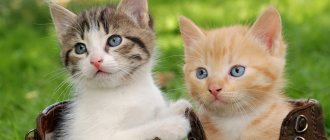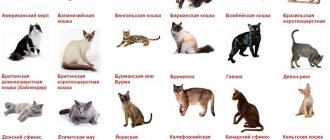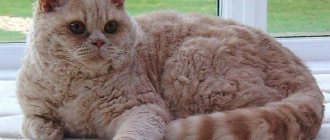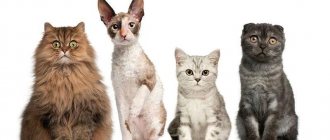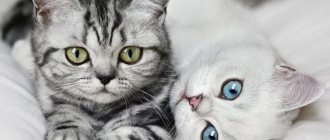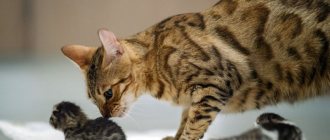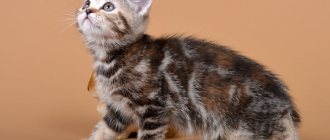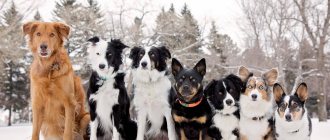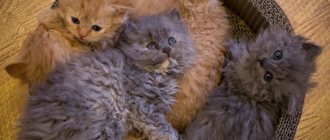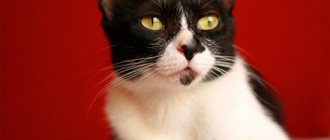Article navigation
A table that will help determine the breed of a catFeatures of pedigree kittensWhat is a breed?How to recognize the breed of a cat by its special coatVery longLong curlyShort curlyHairlessClassification of breedsHead Main distinguishing featuresSize and body structurePawsTailShape of earsType of fur and colorHow to determine the breed of cats by sizeBig catsSmall catsMuzzle shapeLong noseDetermination by sizeMethods determination of cat breed by body size
How to recognize a cat's breed by external differences
Studying some anatomical features will help determine the breed of a cat.
Ears
A purebred aristocrat cat can be identified almost unmistakably by the shape of its ears:
- only the American Curl has folded and turned-back ears (sometimes a full 180°);
- The ears hanging on deformed cartilage, folded in half and sometimes seeming to be stuck to the head belong to the Scottish Fold cat. However, a kitten of this breed can also be born straight-eared (Scottish Straight);
- Low-set, small, bent down and forward, ears that fit tightly to the head are found in the Highland Fold;
- if only the very tips of the ears, devoid of any vegetation, droop forward (as if falling off), then we have a Ukrainian Levkoy;
- The extravagant hairless elf has very large, open ears, widened at the base with smoothly curved back rounded tips;
- the large, handsome Maine Coon can be recognized by its large, triangular, pointed ears ending in characteristic tassels;
- the combination of hanging ears and curled fur distinguishes the poodlecat;
- those with disproportionately large ears may belong to Abyssinians or Orientals.
Short tail
An undoubted innate sign of a cat's aristocracy is short tail. The exception is cases of unexpected loss of the cat's tail (for example, pinched by doors) or its deliberate removal (docking).
The absence of a tail, short length or severe deformation (joints and fractures) are characteristic of the following cat breeds:
- all bobtails (Kurilian, Mekong, Japanese, American, Karelian);
- pixiebob;
- kymriku;
- to manx.
Short-tailed pixie-bob cat
Short-tailed cat breed - Cymrik
Little paws
Short legs are extremely rare in nature; all cats with disproportionately small paws are artificially bred. You can find out the breed of your own kitten by this sign almost without error.
The dachshunds of the cat world are:
- minskin;
- Dwelf;
- bambino;
- Skookum;
- munchkin;
- Napoleon.
Is your cat small?
Pedigree small cats are those cats that weigh less than 3 kg.
But the smallest cat among the little ones is considered to be a tiny cat (in the literal sense of the word) Fiz Gol of the Munchkin breed. The baby is already several years old, but she will not outgrow her 15 (!) centimeters in height.
Having measured the height of your cat, are you ready to call representatives of the Guinness Book of Records? Let's try to find out the cat's breed from the photo:
- Munchkin. You won’t walk the catwalk with such short legs, but small legs left a big mark on the history and formation of small cat breeds
- Napoleon (the result of crossing munchkins and Persian cats). Typically weighs about 2.5 kg
- Bambino (the result of crossing this time short-legged munchkins and hairless Canadian sphinxes). Lower weight bar – 2.2 kg
- Lambkin, a curly-haired lamb cat. An adult lambkin can weigh 1.8 kg
- Skookum (the ancestors of this breed include the Munchkins and LaPerm cats already familiar to us, the ones with such long and wavy hair
- Dwelf, a hairless breed created according to the formula: Munchkin + Canadian Sphynx + American Curl. The weight of these babies rarely exceeds 3 kg
- Singapore cat (Singapura), a breed that migrated from Singapore to the USA, and then to Europe
- Minskin - no fur, no height, weighs little
- Kinkaloo is an extremely rare cat breed. Today there are only a few cats of this type in the world. By the way, for reference, a Kinkalow cat sometimes weighs 1.3 kg
- Skif-Tai-Don is a record-breaking breed, the smallest breed of domestic cats. Skif-tay-don is the first, so to speak, working name of the breed. The international community knows mini cats as toybobs, i.e. toy bobtail.
Exhibitions: how to get there and why?
Purebred cats and cats of noble breeds receive the right to participate in exhibitions. People gather at these events for various reasons: some people win prestigious titles with their pets, some simply want to communicate with passionate cat lovers, and some want to find a purebred pet for themselves.
WCF Direct Member Certificate
The largest international organization of cat lovers is the World Cat Federation (WCF). It includes 540 clubs from all over the world. WCF holds an average of 300 cat shows annually, a third of which are in Russia.
What does it take to get to a cat show?
Anyone can come to the cat show, but you can only take part with a pet that is already 3 months old. In order for your pet to be included in the list of participants, you need to prepare the following documents:
- a certificate with notes on vaccinations and antiparasitic treatment;
- certificate from a veterinarian in form No. 1 for a period not older than 3 days or in form No. 4.
Which cat is purebred?
A cat is considered purebred if it has a number of characteristics (genotypic and phenotypic) that correspond to a certain group of animals artificially bred by humans over several years.
A purebred animal has a pedigree that indicates 4–5 generations of relatives. The document is issued by a felinological club or system. That is, having a similar exterior is not enough to reliably identify the breed. A document confirming the breed is required (usually a pedigree) officially certified by a club or felinological system.
In order to professionally engage in breeding work, exhibit a cat at exhibitions and receive high marks, it makes sense to immediately purchase an animal from a trusted club or nursery with a confirmed pedigree. In all other cases, the pet will be considered outbred. Because otherwise it is impossible to check how “pure” a cat is by breed.
The test is not for weaklings: guess the cat from the photo!
Do you consider yourself a real connoisseur of cat breeds? Prove it to yourself and your friends by sharing your test result!
Write a comment!
I was sure that I understood cats much better! But the test made me tense up
I didn't expect this from myself. It seems like a small thing, but it’s nice.
6 out of 17 I’ll probably go into dog breeding
17 of 17 ... But I still love dogs more, sorry, funny fluffies who are already hungry at five in the morning, and are ready for breakfast at seven in the morning
Surprised. I am a cat lover. I leafed through one book about cats to guess who could become the father of my cat, because... her blue British mother gave birth to 5 completely black kittens. I made a mistake 2 times.
7 out of 17. I thought that I understood cats better - it turns out that I still have to study and study.
Why determine the breed and when is it necessary?
It may be necessary to determine the breed of a cat if:
- The pet was purchased from unknown persons, without documents, and it must be registered at a veterinary clinic or felinological club.
- Mating with a purebred male (female) is planned.
- A cat found on the street or abandoned needs to be given an accurate diagnosis, which may be related to hereditary or specific diseases.
- A pet is beautiful and unusual and many people want to have the same one, or a photo with a cat has made them want to have an animal of this type.
To register a furry friend in the association of felinologists, it is necessary to have a pedigree or birth certificate - birth documents that indicate both parents with their document numbers and titles.
Javanese Burma
Both must be certified by a seal and contain information about the club and nursery. Even if an animal is born from a titled pair of the most expensive cats, without official paper it will be considered outbred.
In order to spend less money when purchasing an animal, many people buy it as a pet-class pet, that is, as a pet, since the price in this case is significantly lower. After which, by any means, even turning to scammers, they try to make a pedigree. This is a big mistake. All purebred individuals are registered in the electronic felinological database. The deception will definitely be revealed and the animal will be disqualified.
Breed class (animal for breeding) and show class (exhibition) do not have the right to be outbred. Therefore, if a furry pet with a pedigree is offered a mating with an animal, even clearly an “aristocrat”, but without documents, you should refuse. Otherwise, you need to understand that the offspring born will not be considered purebred.
If a cat is found on the street, then, first of all, it should be taken to a veterinarian to identify diseases and undergo vaccination.
It is not worth using such an individual to produce offspring, even if the tramp looks like, for example, a handsome Bengal. It is unlikely that a purebred animal will end up on the street. And it’s impossible to make a pedigree for him.
Ocicat Snowshoe Siberian cat
But if your pet has obvious health problems, then it is advisable to find out whether it belongs to a certain type. Some feline “aristocrats” are characterized by characteristic diseases. Diagnosis can be greatly simplified.
It is possible to determine the breed from a digitized photograph by doing a “picture search” on the Internet. Or if there are characteristic features - a short tail, characteristic ears, fur and color - formulate a description task in a search engine.
Is an animal without documents a purebred animal?
So, you ask, is a cat without documents a purebred? Many people feel offended because they thought that they were the owners of a purebred animal. In any case, at the time of purchase, the seller assured so...
The only way to know a breed 100% correctly is on the basis of documents of origin - this is true. At the same time, it often happens that a cat without documents is in fact a purebred or a mestizo. For example, he was born from purebred parents or parents of different breeds, purchased from a nursery not for breeding (without documents or marked “not for breeding”), but then an unscrupulous buyer decided to mate them. A pair of the same breed will produce a purebred cat. But this is not legally confirmed in any way, he will not participate in exhibitions, kittens with documents, that is, with a confirmed breed, cannot be obtained from him.
Sometimes a purebred animal can be picked up on the street: unfortunate owners sometimes throw even purebred animals out of the house. But in such cases it is still impossible to reliably recognize the breed. One can only guess whether the cat is purebred, or simply looks like the breed. In the “Kittens are waiting for owners” section in the “Murkotiki” group, in addition to purebred kittens, they also post abandoned cats that look like British and Scottish cats. If you want such a cat, you can pick it up from the volunteers. It will be a good deed and free.
In general, you probably only need to know the breed if the cat is going to participate in a kitten breeding program. Having such plans, you must complete felinological courses and buy an animal from a nursery with permission for breeding. It will cost more, but everything is legal.
In other cases, you simply love your pet, regardless of its origin. And this is correct, because love is not measured by criteria such as breed, purebred or price. It happens that a purebred animal is kicked out of the house, and it happens that an absolutely purebred dog with an average appearance and not the best character is loved simply because it exists. It depends only on the particular person and his ability to love.
Rate and share!
How to find out the cat breed: classification
Phenology clubs are responsible for assigning breeds to cats. Each breed is documented by certificates and meets basic standards.
The first priority in determining the breed is the appearance of the pet. Many factors are assessed, including body build, color, shape of ears and paws. It is the combination of these factors that influences. Thus, Russian Blue and British cats have similar colors, but different exteriors: the former are more refined, with an elongated body, and the latter are strong and massive.
Despite the lists of breeds, it is hardly possible to track their exact number
Now in the world there are about 60 breeds and 200 varieties of cats. It is almost impossible to accurately count their number, even despite the clear gradation by characteristics. The generally accepted classification divides all cats into 5 groups.
Table 1. Classification of cat breeds
| Description | Representatives of the breed | |
| Shorthair | ||
| Slender | Graceful physique; elongated torso | Siamese; Singaporean; Oriental |
| Average | Small body | Burma; Blue Russian |
| Strong | Very large body | European; Burmese; Exotic; American |
| Longhair | ||
| Long coat, wavy or straight; average build | Nibelung, Norwegian Forest, Maine Coon, Ragdoll | |
| With mutations or abnormalities | ||
| Small paws; Crooked ears; Lack of wool. And other possible deformations and discrepancies with breed characteristics | Sphinx, Rex; Bobtail; American Curl |
If, after lengthy examinations and manipulations, it was not possible to find out the breed, you should contact a veterinarian, professional breeders, or chat with cat lovers on specialized forums. In any case, it is worth knowing exactly the breed of your pet.
A veterinarian can also help determine the breed.
Thoroughbred vs mongrel: distinguish by test questions
Sometimes it is not enough to look at a photo to find out whether a cat is purebred or not. It is necessary to carefully study the pet and find answers to questions that will allow you to think about the true nature of the pet.
So, consider your pet and ask yourself:
- Is the size of the cat smaller or larger than the rest of his furry brothers?
- Does your pet's color look unusual or is it at least somehow different from the color of ordinary cats?
- Are there differences in the hair structure – waves, small curls, too long hair or other features?
- How developed are the limbs, ears, and tail? Are there any noticeable differences?
- Are there any other details in appearance that distinguish your pet from the neighbor's mongrel cat?
Sometimes the pedigree of cats lies “on the surface”, sometimes it does not have clearly defined identifying details
If you answered “yes” to at least 1 question, then your cat is special. To accurately determine its noble breed, it is necessary to delve into the details. So let's get started.
Main distinguishing features
Externally, cats have more or less the same appearance. These animals have a rump and chest of medium width, and the head is rounded. In members of different species, certain aspects of their appearance acquire certain functions through reproduction. Belong to them:
- body size;
- Ear water structure (unusual shape, deformed cartilage, curled, etc.)
- Limbs (short, normal, elongated)
- fur;
- hair color.
Based on these parameters, you can indicate whether the animal belongs to a certain species. Let's look at them in more detail.
Body size and structure
The length of the average domestic cat is up to 75 cm. Their tail is about 30 cm long. Standard males weigh 4 and 6 kg and females 2.3 - 4.5 kg. Some breeds weigh much more, their body weight can reach 20 kg.
The largest races include:
- American Bobtail;
- Smoked Bobtail;
- Maine Coon;
- British cat;
- Norwegian Forest Cat;
- Ragdoll;
- Pixiebob;
- savannah;
- Turkish cat vans;
- Siberian;
- Chartreuse.
There are also small species that weigh no more than 2.5 kg. These include Bambino, Napoleon, Dulf, Kinkalova, Lantzkin, Minskin, Skif Tai-Donu, etc.
Paws
Most cats have limbs of medium length. However, many purebred animals have short legs. According to this feature, you can easily distinguish blue bloods from ordinary backyard animals. These short-earth legs are Napoleon, Minice, Dwefy, Skooki, Bambino and Munchkins. Small paws are compensated by the mobility of the spine. This spine will help you move easily with short limbs.
Tail
Cats usually have a long tail. However, some varieties have a short tail, which is a congenital trait and not a consequence of surgery. Pedigree animals can be easily recognized by this seal. However, you should check whether the short tail is not the result of injury. Breeds that have unusual tails include:
- A cat without a tail and short forelimbs. For this reason, it has a boot walk;
- The tail is only 2 and 15 cm long;
- Animals without a tail or with a very long tail;
- American Bobtail tail length no longer than the base of the hind legs;
- Japanese bobtail about 12 cm long;
- Kurilian Bobtail.
Even the rarest races can be easily recognized after building the tail.
Ear shape
Non-studded animals have a typical mustard design. With aristocrats, the ears often have an unusual appearance:
- Tilt up to 180 degrees; American curl;
- with deformed cartilage, which collects mustard up to half; Scottish spotted cat;
- Curly; from representatives of Ukrainian diversity LWIE CAT;
- Patterned and large in size; Elf cat.
Other aristocratic races will have ears similar to one of the types described above.
Coat type and color
The definition of a purebred animal is always based on the Ukan and its coloring. All aristocratic varieties have their own characteristic hair cap colors.
Breeds differ in hair length. For short-haired varieties include: Tonkiy, Siamese, Abyssian, Singaporean, Cork, Bombardier. Maine Coon, Simrak, Persian, Balinese and Ragdoll Wu Long hair. There are also hairless species, the Ukrainian lion and the sphinx.
Curly short hair is found in almost all varieties of Rex: Germanic, Devonian and Cornish cats. Long-haired curly breeds are Behema and Selirk Rex. American Shorthair breeds have a coarse coat with bouncy curls.
It is necessary to understand that the presence of an unusual color in a street kitten already indicates the presence of aristocratic relatives.
Varieties such as the Thai, Nevsky, Balinese and Siamese have dark paws, muzzle and tail. The Ragdoll, Burmese and Snow Show members all have white socks and a black tail, paws and mouth area.
Russian Blue, British and Nibelung are distinguished by their smoky gray or blue color. Abyssinians and Somalis have a sandy color. Bengals, Egyptian Mau, Safari and Savannah cats have bright stripes and spots. Havana, Brown or Tiffany-Chantilly have brown fur.
Mestizos can have characteristics of several races at the same time. This is a common occurrence when species mix. Despite the differences noted above, only a breeder or veterinarian can accurately determine the breed.
Using the above parameters, you can approximately determine whether we have a purebred cat or not. No matter what type of cat it is, it needs a balanced diet, good and proper care and love from you.
How to find out a cat's breed by coat color
Very often it is possible to distinguish a purebred aristocratic cat from a simple Murka by color. Domestic cats are usually very plainly colored, two or three colors, and have large spots or stripes.
Experts have worked thoroughly on the colors of purebred animals. Sometimes you can immediately determine the specific breed of a kitten using this feature.
Siamese
The striking Siamese color, the so-called color point, is characterized by darker areas on the cat's face, ears, paws and tail.
Initially, only Thai or Siamese cats could boast of this, but over time, breeders gave this coloring to many breeds:
- Balinese;
- British;
- Neva Masquerade;
- Himalayan;
- Burmese;
- Persian;
- ragdoll, etc.
Cat with Siamese color - Balinese
Himalayan cat with Siamese color
There are several varieties of point colors in cats, depending on the contrast of colors and the smoothness of the transition from dark to light:
- seal point - soft cream;
- blue point - silver-blue;
- chocolate point - brown-chocolate;
- lilac point - pinkish-bluish;
- red point - pronounced apricot (red);
- cream point - delicate beige-amber;
- caramel point - grayish-beige;
- cinnamon point - red-brown;
- fawn point - pale cream.
Cat with chocolate-point color Only a specialist felinologist can accurately determine all the nuances of point colors. A kitten is always born white. The marks (points) begin to darken after a few days.
Blue
Solid blue color, also known as grey, is traditionally considered an integral feature of British breed cats. It can be detected immediately even in a newborn kitten. But in fact, all shades of grayish blue are also found in many other purebred representatives of the cat world, such as:
- chartreuse;
- Maine Coon;
- Russian blue;
- Scottish;
- oriental;
- Nibelung;
- korat etc.
Breed: Russian Blue cat
Sand
If the kitten has a rare sand or red color (sorrel), then this allows us to determine whether it corresponds to one of the breeds:
- Somali;
- Abyssinian
A cat with a sorrel coat color is an Abyssinian breed
Wild
Natural animal colors, making cats smaller copies of tigers and leopards, are called wild (tabby) and are found in the following breeds:
- savannah;
- ocicat;
- Serengeti;
- Bengali;
- Egyptian Mau;
- caraquet;
- Kanaani;
- Kurilian bobtail;
- safari, etc.
The Kurilian Bobtail is a wild-colored cat. Most often, wild colors are characteristic of hybrid breeds. You can instantly determine who belongs to them.
Brown
The uniform and monochromatic brown color of a kitten's fur coat will immediately determine its royal origin and worthy position in the cat elite. This color is practically never found in the wild.
Cats of the following breeds come in similar colors:
- British;
- oriental (havana brown);
- Burmese;
- Scottish;
- Abyssinian;
- Persian;
- Chantilly-Tiffany, etc.
Burmese - a cat with a brown color
How to find out the gender of British kittens?
Determining the sex of small British kittens is quite difficult.
Primary sexual characteristics are just being formed, and the thick fur hides subtle differences.
But you can still find out the gender by the following signs:
- In this breed, a clear sexual difference is the shape of the anus and genitals. The presence of two dots indicates that the baby is male, and a “question mark” indicates that the baby is female.
Feeling the testicles does not always help accurately determine gender.
This is due to the fact that at birth, both the British cat and the female cat may have swelling in this place.
British kittens are affectionate and peaceful
- The presence of nipples also cannot be considered a clear difference. Kittens of both sexes can have them. In females they are more pronounced, but this can only be understood by comparison.
- Another sign of how to distinguish a cat from a cat of a given breed is its habits.
- The sex of adults can be determined by external characteristics. Males are much larger than females. The latter are more elegant. You can also distinguish the sex by the face: in cats it is narrower and more elongated.
According to body size
The domestic cat or female cat grows to a small size. On average, their body length ranges from 70 to 75 cm. The size of the tail of a domestic cat is slightly less than half of the body - 30 cm. The body weight of adult cats ranges from 4-6 kg, while the weight of cats starts from 2.3 and does not exceed 4.5 kg.
If you, as an owner, suddenly notice that an adult cat is too small for its age or its size is large, then you should doubt its outbredness. The breed is not determined correctly based on one trait, so you need to carefully study additional parameters.
If your cat is too large, then perhaps he is a representative of one of the oldest breeds:
- Norwegian forest cat, males of which can reach 10 kg in weight.
- Pixiebob is a cat similar to a wild lynx, artificially bred in America. Female pixie bobs gain no more than 5 kg, while males of this breed have a body weight close to 10 kg.
- Siberian cat. Females of this breed do not exceed 6 kg, males - 12 kg.
- Maine Coon. An adult cat of this breed has a maximum weight of 8 -8.2 kg, a female cat - 5.4.
- Chartreuse is a cat nicknamed cat-dog. The maximum weight for adult cats ranges from 6-7 kg, for female cats - 4-5 kg.
To this list you can add the American and Kurilian bobtail, British cat, savannah and ragdoll.
If a domestic cat has reached adulthood and is far from normal in size, it may be a member of a certain breed. Usually a purebred cat is one whose weight does not exceed 3 kg.
The smallest cat in the world is a munchkin breed with the nickname Tiny Cat. An adult cat belonging to this breed does not outgrow 15 cm in length.
© shutterstock
To determine a breed by size, it is important not to lose sight of other details, because some breeds have the same weight, but differ in coat color.
that cats and domestic cats were once a steppe cat (and purebred cats - such a cat should belong to a cat (this includes a cat, even fold-eared cats, but a Siamese cat, an Abyssinian cat, cats, cats and features of color and eyes, coat color, main color) dense, corresponding to the color, short-haired, color options, Nosiamese color with
muzzledogfaceread more
Methods for establishing the breed
When buying a kitten or choosing a partner for a domestic cat during mating, you can reliably establish the variety only by looking at it in the relevant documents from the club to which the animal is assigned (if any). If there are no such documents, then the breed is also missing.
Often, unscrupulous breeders breed cats from different breeds with each other, mate pets of the same breed and outbred cats in order to obtain offspring with purebred roots and subsequently pass them off as supposedly elite. In this case, it is impossible to judge belonging to one or another variety based on the similarity of standard characteristics. Belonging to it is determined by the following documents:
- for kittens - according to a litter certificate (if registration was carried out in an American club) or according to an individual metric (if registration was carried out in a European club), as well as according to the pedigrees of the parents;
- for adult animals - according to the pedigree, which was issued by the club and certified with a wet seal (the telephone number and address of the organization and the name of the head of the club are required).
In the veterinary passport, information about the breed is entered only at the request of the owner. Because of this, it cannot serve as a reliable means of establishing breed.
If you find an animal on the street, you should pay attention to the fact that purebred cats are rarely strays. If a street animal has any purebred characteristics, then it is most likely a mestizo
If you have a photo of an animal, you can determine its breed in the following ways:
- If you have a digital image and have access to the Internet, you can use the online image search function, which most search engines are equipped with today. If the photo is posted in the cat owner’s personal photo album or on a specialized resource, you should contact the owner or site administrator to clarify the information.
- Go to a cat show and try to find an animal there that is as similar as possible to what is shown in the picture. For reliability, you can show the photo to judges or nursery owners, giving them a kind of test.
- Try to find in the photo any signs by which you can distinguish the breed. These may include long curly fur, curved ears, and the absence of a tail. These characteristics are usually specified in the breed guide.
Breed classification
Felinology is a science that studies the anatomy and physiology of cats, their reproduction and selection. There are many systems for recording and assessing animals in this area. For the most part, they come down to two groups - American and European.
At cat shows, without exception, everyone is judged by genotype. Family affiliation and origin are determined by the pedigree - the main cat document, which, in fact, reflects the family tree of the pet, at least up to the fourth generation. In addition to the names of the ancestors, all colors and dates of birth, the names of the nurseries where the animals came from are indicated.
The data of the club and the association itself are necessarily recorded in the “header” of the document.
Each pedigree has its own number, by which it can be easily found in the electronic accounting system. Colors are designated by specially adopted codes.
Such a document not only indicates the pet’s ancestral affiliation, but also allows you to determine which genes it is a carrier of, and what kittens it may have.
Only the oldest American system, TICA, as the most democratic, allows assessment by phenotype - the appearance of the animal.
In this system, all individuals are divided into six categories:
- Category I - Established Breeds - lines formed as a result of selection.
- Category II - Natural Breeds - natural breeds.
- Category III Variant or Mutation Breeds - the result of genetic mutations.
- Category IV - Domestic Hybrid Breeds - interbreeding.
- Category V - Non-Domestics Source Breed Hybrids - crossing of domestic and wild animals.
- Category VI - Experimental Breeds - experimental breeds.
The cat's status code is indicated by a set of Latin letters and numbers (date of birth and personal number).
If the alphabetic code SB is written in the pedigree, such a pet is a full-fledged representative of one of the recognized breeds. Its designation and the name of the animal (usually includes the nursery's own name) are written in the first line.
There are four categories in the European WCF system. Cats are divided according to the type of cover:
- Category I - Shorthair I - animals with short hair, group 1 - includes Orientals, Siamese and Thais, Peterbald and Tonkinese cats.
- Category II - Shorthair II - animals with short hair, group 2 - all other shorthaired animals.
- III category - Semi-Longhair - semi-longhaired cats - Siberian, Maine Coons, Norwegian Forest, Nibelung, others.
- Category IV - Longhair - long-haired group - Persian only.
In this system, the pedigree number encrypts: breed, category, color and sex of the animal. A cat from the experimental group or an unrecognized variety will not be issued a document in this system.
Pedigrees of other systems are not very common in Russia. But if you need to decrypt them, you should contact the club that issued it.
Information about him and the feline system, indicating telephone numbers and addresses, is required in the document of any association.
Singapura Siberian cat
Traits associated with genetics
There is such a thing as sex-linked inheritance of traits. Thus, individuals with a three-color coat color will definitely be female, since the simultaneous presence of bright red, white and black colors guarantees the presence of two X chromosomes. (XX – female, XY – male). A genetic pathology (triploid set of sex chromosomes XXY) occurs very rarely, when cats have this coat color, but they cannot have offspring. Also, calico and tortoiseshell colors belong only to cats.
There are obvious differences by sex in mature animals during the period of sexual heat, which, as a rule, occurs no earlier than 7 months:
- Cats begin to more actively mark the surrounding territory, filling your home with a specific smell, become anxious, noisy, and try to go outside.
- Cats make heart-rending sounds day and night, fawn over others, roll on the floor, and arch their backs.
Why can a cat be left without a pedigree?
- Breeding animals may produce offspring that do not meet the breed standards. Such kittens are rejected. They can be adopted/sold, but a note is made that they are not suitable for breeding. Many unscrupulous owners still find a partner to mate their pet (of the same breed or another). The result is phenotypically good kittens, but without documents. It is worth noting that they cannot be bred in the future, but the next owners most likely do not know about this.
- Even a high-breed cat can get lost, run away, or, at the owner’s request, deliberately remain on the street.
- A purebred kitten (or adult cat) was given or given away, but without documents.
Determining gender by external characteristics
Another way to distinguish a cat from a cat is to carefully look at the face and body of the animal.
However, this method is suitable for avid cat lovers.
A person who determines the sex of a cat for the first time is unlikely to be able to do this accurately.
A cat differs from a cat in the following ways:
- You can determine the sex of a cat by its face and nose. They are quite wide;
- he has a powerful and large physique;
- paws are thick;
- A castrated cat can be distinguished from a female cat by its large head and thick skin.
External signs of a cat:
- has a more graceful body, graceful curves. This is especially noticeable in short-haired breeds like the Oriental, Savannah and Cornish Rex;
- if you try to find out the gender by the muzzle, then you need to look at its elongation: in cats it is more elongated in length rather than in width.
This can be seen in the photograph: the muzzle is narrow and elongated.
Gracefulness is the main characteristic of a cat
Another external sign of how to distinguish a cat from a cat is color:
- If a kitten at birth has a tricolor or tortoiseshell coloration, then we can say with complete confidence that it is a cat. This is due to a genetic feature. For the appearance of black, white and red colors in the coat, two X chromosomes are needed. And only females have them. A cat can only develop this color in the case of a genetic disease, which is quite rare.
- The color Calico also belongs to cats;
- Only cats are red or cinnamon colored.
You can sometimes accurately determine a cat's gender by coat color.
Caution when handling kittens
When examining babies, you need to be as careful as possible. The kittens' bodies are not yet strong enough, so even an accidental awkward movement or slight use of force can injure the pet.
Photo: you need to be careful when examining kittens
It is very important to consider the age of the kitten. Newborn babies should not be separated from their mother until they reach one month of age.
You need to lift the kittens carefully by the scruff of the neck (in no case by the tail!), holding it lightly. Try not to hold the baby in your arms for more than two minutes, otherwise his mother will be very worried
Determining the sex of a kitten is not as difficult as it might seem at first glance. With just a little practice, you will be able to distinguish a boy from a girl even by the outline of his face.
Cat classification
Cats are not distinguished by a variety of external forms, which cannot be said about dogs. Even despite their abundance and distribution throughout the planet, all cats are, in principle, very similar.
Active breeding work by felinologists began only at the beginning of the last century. And even at the present moment, when a clear gradation according to breed has appeared, it is difficult to judge how many purebred cats there are in the world. It is worth recognizing that the majority of domestic cats are still ordinary “nobles,” that is, completely outbred.
To date, the cat world has about 60 breeds, which also include two hundred varieties. According to the current classification, cats are conventionally divided into 5 large groups, which differ from each other in the length of their fur and features of their body structure:
- longhaired: Burmese, Persian, Ragdoll, Turkish, Norwegian Forest, Maine Coon, Somali, Balinese, Siberian, Cymric;
- shorthaired with a strong constitution: European, American, Burmese, Chartreuse, exotic;
- shorthaired with medium constitution: blue, Abyssinian, Burmese, Bombay, Korat;
- short-haired with a slender body: Siamese, Oriental, Singaporean, Tonkinese;
- cats with deviations in skeletal structure and mutations: male, Scottish fold, bobtail, multi-fingered, sphinx, rex.
Advice on how to prove a cat's pedigree
If your cat does not have a “passport” (pedigree metric), this does not mean that he is not purebred. Let's say you have studied all the characteristics and photographs and found that your pet fully meets the requirements. If you wish, you can contact the nearest nursery that specializes in breeding a specific breed and ask professional felinologists to study the cat (). If the experts do not find any reason for rejection, then you will be given a document with the pedigree of the first generation. It gives the right to participate in exhibitions (though in special categories where similar “pioneers” of their breed are presented).
An example of what a pedigree metric looks like for a Siberian cat
All breeds have strict requirements for appearance and character. By comparing the standards and finding full compliance with the characteristics of your cat, you can make an assumption about the pedigree of the four-legged pet. This is sufficient to assign the status “phenotypically similar to (name).” There is even a chance to get a pedigree metric of the first generation - a document confirming the pedigree of cats with unknown parents.
Determined by photo
In addition, you can determine the breed of a cat from a photograph.
- If the photo is digital, then you can try using a function such as “search by image.” If it was posted by the owner in a personal album, then you can contact him directly and find out the answers to all your questions.
- In addition, you can study the photo very carefully and determine the breed by its external characteristics.
- Take a photo and go to an exhibition of purebred cats. There you can simply take a closer look at the appearance of the animals and consult with breeders who can answer any questions you may have.
We invite you to read: Baldness in cats: description, photos, causes and methods of treatment
Google Lens - will help you learn everything about animals
Since 2021, Google Lens has been able to recognize the breeds of cats and dogs and identify other animals. In real time, the artificial intelligence system recognizes objects from the uploaded image and then provides the user with the result.
This application is supported in Google Photos, Google Assistant and on some smartphone models even in a regular camera. Also, Google Leans can be installed from the Android app store.
How can I use it to obtain the necessary information?
- Go to the application and click on the camera button.
- Now either take a snapshot here and now, or download one that's already stored in your gallery.
- After this, you should wait a few seconds and Google Lens will offer you to review the information received.
Now you will see the result, and you will also be able to learn even more about this breed if you start looking for information about it on the Internet. Google Lens also offers not only the name, but also a description of the breed.
This is interesting Where to get a car inspection in 2021 in Yekaterinburg addresses and telephone numbers

